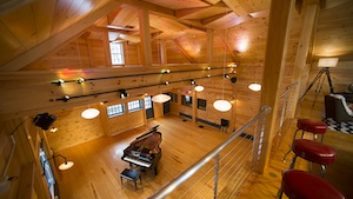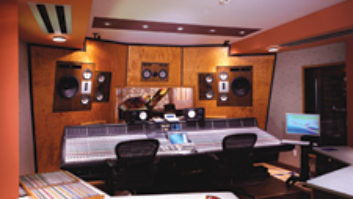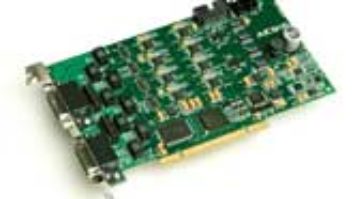
Prism Sound Dream converters are well known in mastering circles for their transparency and detail, and the ADA-8 continues the tradition of fine design and excellent construction. The Dream ADA-8 provides eight channels of up to 96kHz/24-bit AD/DA conversion for high-quality audio production. Multichannel mixing and mastering facilities will find its flexible interface options especially useful. Although the unit is not cheap (from $8,700 to $11,700), its field-upgradeable components ensure that it will remain viable after other converters have been consigned to the slagheap. Digital I/O modules, AD/DA boards and even the DSP engine may be upgraded; firmware upgrades are also available.
INS AND OUTS
The Dream ADA-8’s back panel has four sections: mains inlet, analog I/O 1 and 2, digital I/O 1 and 2 and the Utility Module. The mains inlet has an IEC socket, a power on/off switch, a two-way voltage selector and a fuse holder. The top eight inputs in the analog I/O section (AIO1) comprise transformerless, electronically balanced, galvanically isolated XLR inputs with software-adjustable calibration level. Dynamic range is 112 dB, RMS unweighted, measured at -60 dBFS. THD+N is -105 dB (0.0004%), RMS unweighted, at -1 dBFS. A switchable Overkiller function (a progressive analog peak limiter) prevents converter overload with soft-knee limiting up to 12 dB beyond nominal full-scale.
The lower eight outputs in the analog I/O section (AIO2) are also transformerless, electronically balanced, galvanically isolated XLR outputs. Dynamic range is 110 dB, RMS unweighted, measured at -60 dBFS. THD+N is -104 dB (0.0004%) typical, RMS unweighted, at -1 dBFS. Because AIO slots can accept either analog input or output modules, the ADA-8 can be configured to offer 16 analog inputs or 16 analog outputs.
Digital I/O options abound: AES3-S/PDIF, Pro Tools MIX, Pro Tools|HD or IEEE-1394 FireWire, all offering eight channels in and out. The ADA can accommodate any two I/O options at the same time.
The Utility module comprises a stereo analog monitor output with balanced RCA connectors, a stereo digital monitor output with a BNC connector, AES11 reference sync input and output, word clock or video reference sync in, word clock or superclock (256 xfs) reference sync out and a serial port with RS-232, RS-485 or MIDI format on a male 9-pin D connector.
THE FRONT PANEL’S FOUR MS
The ADA-8 front panel features the Monitor, Mimic, Meter and Menu panels. At the extreme left is a switch to toggle the ADA-8 in and out of standby power mode. Below the switch is a headphone jack for 2-channel monitoring. The Dream ADA-8 has two 8-channel paths that can be monitored and metered separately and synchronously. Typically, these two paths will be the AD/DA signal paths.
The Monitor panel controls the 2-channel monitor and displays its parameters. A blue Access button calls the appropriate menus on the ADA-8’s LCD. You can monitor in Pairs mode (where adjacent channel pairs are monitored) or Mixed mode. In Mixed mode, a mix of any of the path’s channels can be created, each with its own gain and pan setting.
The Path Selector button toggles between path 1 and path 2. Pre Post selects whether the monitor path will be sent pre or post the processing section. Cut mutes the signal path, and the Invert button phase inverts both channels when selected. Engaging the Mono button causes both channels to be mixed together at both outputs, and the Swap button exchanges channels A and B outs. A two-button volume control may be defeated in the Monitor options menu.
The Mimic panel shows the signal flow through either path 1 or path 2 — from source through processing to destination. Path 1 and path 2 are switchable. Other function buttons are circumscribed by flow chart boxes that have access buttons to call up companion menus related to the specific box. The sync source/sample rate box indicates sync source (local, word clock, AES, video, D|1 or D|2) and sample rate (32k, 44.1k, 48k, x2, x4 and =ext). The source box shows which ports are assigned as inputs to the selected path: analog (1, 2), digital (1, 2) and a Split96 indicator that shows when the digital inputs are used in two-wire mode. Mic and 48k LEDs indicate that analog input modules with a mic pre facility are selected with the mic pre function and phantom power toggled to on. The Overkiller LED shows that one or more inputs in the path have their progressive analog limiter switched on.
The decode box indicates signal path word length (16, 20 or 24-bit) and which decode algorithms are in use. The MR-X LED shows that Prism Sound’s MR-X format is engaged. This is a word-mapping scheme that sacrifices tracks to record higher sample rates or longer word lengths to a multichannel target that has a lower native format.
If the DRE LED is lit, one or more channels are being decoded from the Prism Sound DRE (Dynamic Range Enhancement) format. DRE encodes extended word length formats to shortened formats without sacrificing an extra channel. It works for recording to media and digital audio signal paths. DRE16 indicates a maximum 16-bit word length for target media or data channels, while DRE20 is used for 20-bit media.
Green LEDs indicate the input signal’s effective word length after decoding. Word length is determined by measuring the number of zero LSBs rather than depending on aux bit definition in the data stream.
The process box has three LEDs: Patch LED, which indicates that cross-channel mixing or patching is selected; Process LED, showing that signal processing functions are active; and Bypass LED, indicating that no patching or processing is enabled.
The dither/encode box indicates word length for the path’s digital outputs (assuming that digital outputs are assigned) and encode algorithms in-use. The 16b, 20b and 24b LEDs in the center of the box indicate word length; more than one may be lit if different output channels in the path have differing word lengths. The SNS LED shows if word-length reduction using the Prism Sound Super Noise-Shaping algorithm is selected for any of the channels. If any of the path’s channels has flat dither selected, then the Flat LED will be lit. The Auto LED lights when auto dither defeat is active. This ensures that no dither will be applied in situations where it is not needed; for example, when doing a straight D/D transfer or sending digital black.
The Dest (Destination) box indicates output ports for the selected path. The green LEDs on the box’s right side include analog 1 and 2, digital 1 and 2 with yellow LEDs indicating Split96, or two-wire mode.
The Meter panel has eight bargraph meters that can be assigned to show levels for either path. Peak hold and overload status may be assigned via the relevant menus. Alert LEDs show various conditions such as input lock status or analog overload killer action, depending on their assigned function. The top row of buttons selects path 1 or 2, pre- or post-processing metering, indefinite peak hold and access to the relevant menus. The Channel Select and All buttons are used together for various programmable functions, such as the quick assignment of the analog overload killer to all channels.
The Menu panel lets the user view and change all parameters and provides 24 stores (four banks of six) for user settings.
I HAVE ONE, I WANT MORE
The ADA-8’s clocking yields excellent jitter rejection. AD/DA paths have independent, multiple PLLs, and imaging is precise for multichannel and stereo audio programs (assuming that the audio in question has excellent imaging).
I tested the Dream ADA-8 with a Pyramix DSD system and was instantly struck by the entire system’s natural sound. I also used it with a Pro Tools|HD 5 Accel system because most of my current projects are at least 96 kHz. I hope that a 192kHz upgrade is coming for this unit because I have several clients requesting that format.
I used the Dream ADA-8 when mixing Read Ridley’s latest film, Dodge City, starring Isaac Hayes and Jackson Bostwick. Matching dialog shot on location with ADR required close attention to subtle nuances in the background ambience and minute tweaking of vocal levels and EQ. Having the Prism meters for constant reference ensured that I maintained dynamic range without losing the quiet scenes or overloading louder ones. It’s one thing to mix music in three-minute programs and another to mix audio for an 80-minute program. I found that the ADA-8 helped offset fatigue because I could hear greater detail without struggling. When I listened to the mix on other systems, I was surprised at how areas I worried about seemed to meld together without seeming “chopped.”
An acoustic jazz project I started in DSD is now in the overdub stage on a Pro Tools|HD Accel system with the ADA-8. After finishing the mix, I’ll transcode back to DSD using the ADA-8. One of the ADA-8’s most useful assets is its ability to do instant format conversion: If I need to go to another system, I just swap modules.
What do you get the person who has everything, including a Prism Sound Dream ADA-8? Why, another one, of course!
Prism, 973/983-9577, fax: 973/983-9588, www.prismsound.com.
K.K. Proffit is co-owner/chief engineer at JamSync, a Nashville facility specializing in surround production.




